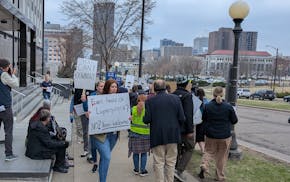Employer health plans could see an enrollment surge as part of the state's push starting this summer to check Medicaid eligibility for some 1.5 million people in Minnesota.
Last month, Minnesota pushed back the first in a year-long series of re-enrollment deadlines to Aug. 1, allowing more time to determine eligibility for residents whose Medicaid benefits were set to expire.
The state Department of Human Services (DHS) estimates that up to 375,000 people currently enrolled in Medicaid may lose coverage as the renewals resume. This disenrollment means nearly 200,000 people might move to employer-sponsored coverage, the Minnesota Council of Health Plans says in an online toolkit about renewals.
Some Minnesotans will lose eligibility because they've found employment, increased income or gained employer-sponsored coverage. The council, which is a trade group for nonprofit health insurers, says it's also likely that some who initially move to employer plans will go back into Medicaid coverage.
DHS projects that 30% to 50% of those who are disenrolled will likely re-enroll after a short period, often due to incomplete paperwork or barriers in the renewal process.
"Over the past two years, the council and our member plans have been working with the state, providers and community groups to prepare for the enormous effort to help the state re-determine the eligibility of 1 in 4 Minnesotans and ensure no one faces an avoidable gap in coverage," Lucas Nesse, the chief executive of the Minnesota Council of Health Plans, said in a statement.
"Gaps in coverage lead to gaps in care and we are committed to making sure Minnesotans have the support they need to maintain their health insurance or find other coverage options to stay connected to care."
Verifications in government health insurance programs used to be routine, but were suspended during the COVID-19 public health emergency. As a result, enrollment grew significantly in the programs, which are jointly funded by the state and federal governments primarily for lower-income residents and people with disabilities.
Losing Medicaid would be considered a "qualifying life event" to receive employer-sponsored coverage, health plans say, so workers would have 60 days to enroll with their company's plan to avoid a gap in coverage.
DHS said it could not assess the accuracy of the trade group's figures for where people might find coverage. The numbers are based on a study from a research group at the University of Chicago that incorporates projections from the Urban Institute, a health policy group.
The study "applies a national lens and not every aspect of the study will apply to Minnesota's market," the department said in a statement to the Star Tribune.
Numbers from the research study suggest that about 15,000 to 20,000 people in Minnesota could move from Medicaid to the individual market where people can purchase subsidized private health plans through the MNsure health exchange. In addition, anywhere from 38,000 to 51,000 Minnesotans could become uninsured due to coverage re-determinations.
DHS officials say the state is working to help as many people as possible maintain coverage. Extended Medicaid coverage during the public health emergency helped lower Minnesota's uninsured rate to 4% in 2021 — essentially a tie with 2015 for the lowest-measured rate in the state since the Minnesota Department of Health began conducting surveys.
"We are in a highly unusual time when many enrollees have not had to complete a renewal process in three years, and those that came onto public program coverage for the first time during the pandemic have never gone through a renewal," DHS said in a statement.
The state has advised beneficiaries to watch for renewal envelopes branded with large blue dots. A lookup tool allows people to learn their renewal dates — each month over the next year a subset of enrollees will go through the redetermination process.
The Secretary of the U.S. Department of Health and Human Services visited Minneapolis in June for an event calling attention to the renewal process.
"Our initial communication to enrollees about renewals began with an informational mail campaign," DHS said in a statement. "DHS is now using additional methods to reach people ... such as texting and live phone calls. And we are exploring other methods including robo-calls."

An inside look at some of the expensive houses for sale in Minneapolis

Laid-off Minnesota Health Dept. workers warn of public health consequences
Second Mayo Clinic union in Rochester votes for right to strike

How Allina doctors are deploying AI to double-check cancer screenings

